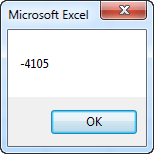If you need to use a value that never changes, it will be wise to use a constant instead of a variable. When you use the constant you can be sure that the value is always the same and you won’t accidentally change it to a different one. If you try, Excel will return an error.
You can declare constants by using the Const word at the beginning.
|
1 2 |
Const monthsInYear As Integer = 12 Const PI As Double = 3.141593 |
Excel VBA Constants
Besides user-defined constants, Excel offers many predefined ones. You can meet them when you use the macro recorder.
Look at the following code generated by the macro recorder. It fills a cell with yellow color.
|
1 2 3 4 5 6 7 8 9 |
Sub fillCell() With Selection.Interior .Pattern = xlSolid .PatternColorIndex = xlAutomatic .Color = 65535 .TintAndShade = 0 .PatternTintAndShade = 0 End With End Sub |
Insert MsgBox(xlAutomatic) before End With.
If you execute the macro it will display the message showing the value assigned to constant xlAutomatic.

If you write .PatternColorIndex = -4105 instead of xlAutomatic it will give you the same result.
